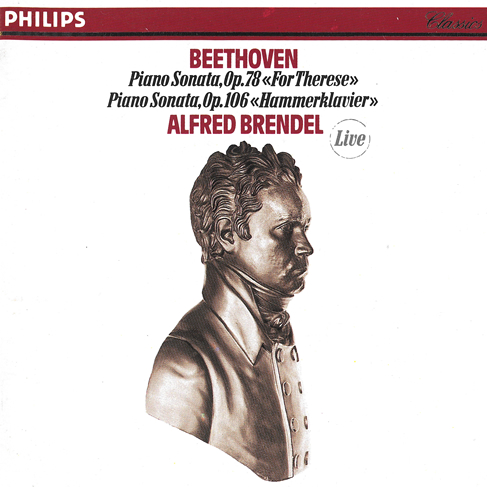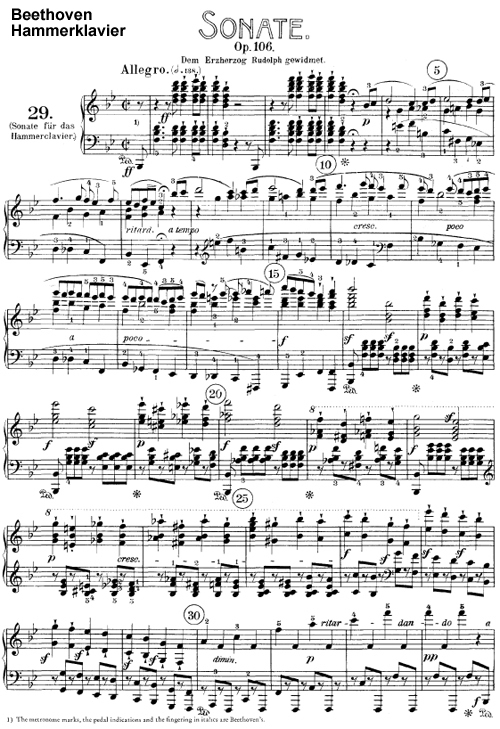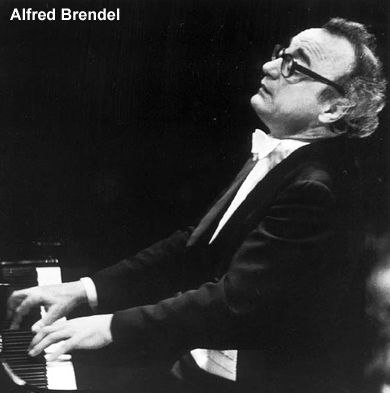 Ludwig Van Beethoven (1770-1827)
Ludwig Van Beethoven (1770-1827)
Piano Sonata No. 29 in B-flat, Opus 106 – “Hammerklavier”
Piano Sonata No. 24 in F-sharp, Opus 78 – “Fur Therese”
Alfred Brendel – Piano
Live recording at Queen Elizabeth Hall, London on October 20, 1982 (Opus 78) and February 2, 1983 (Opus 106)
ONE-SENTENCE REVIEW:
Beethoven + Alfred Brendel = MAGIC!
ORIGINAL LINER NOTES (by Alfred Brendel):
Live recordings remind the listener of the fact that concerts involve risks. Whereas in the recording studio musical continuity is more often achieved as a result of careful scrutiny and painstaking labor, it has to come about on stage in one single breath and without a safety net. It has to work on the spot, and the public is part of its success or failure.
 Beethoven’s Sonata Opus 106 has remained one of the supreme challenges of the pianist.
Beethoven’s Sonata Opus 106 has remained one of the supreme challenges of the pianist.
Even today, it shows up the outer limits of what a composer of sonatas can accomplish, a performer can control, or a listener can take in. In a magnificent exertion of will, the work combines grandeur and filigree, openness and density of detail.
The player should muster endurance as well as boldness, fierce intensity as well as the cool grasp of a panoramic overview.
Czerny, who had played the sonata for Beethoven, describes the tempo of the first movement as “uncommonly fast and fiery.”
The initial theme relates to the rhythm of the words “vivat, vivat, Rudolphus” (it was the Archduke Rudolph to whom the sonata is dedicated).
Two elements, the tension between the keys of B-flat major and B minor, and the interval of the third, are decisive in the unfolding of the vast design. The intrusion of B minor (the “black key,” according to Beethoven) into the recapitulation of the first movement has grave consequences: not before the final fugue is this conflict resolved.
In the code of the scherzo, eerie juxtapositions of B-flat and B natural present the problem bared to its bones. We encounter the “black key” once more at a declamatory climax of the Adagio (“con grand’ espressione”) and, finally, in the cancrizans of the fugue.
For both B-flat major and B minor, the related thirds are G and D; these are the only tones the two keys have in common. In G major, there is the second thematic group of the first movement, and the inversion of the fugue. The “religious” D major sphere is given to secondary themes of the Adagio and the fugue.
 Beethoven’s special contribution as a fugal composer is the turbulent and frenzied fugue that nearly, but only nearly, defies the strictures of contrapuntal writing. Boundless energy and intellectual rigor have never been coupled on a higher pitch of excitement.
Beethoven’s special contribution as a fugal composer is the turbulent and frenzied fugue that nearly, but only nearly, defies the strictures of contrapuntal writing. Boundless energy and intellectual rigor have never been coupled on a higher pitch of excitement.
The slow introduction of the fugue resembles in its psychological situation the final movement of Beethoven’s Opus 110: after its “exhausted lament,” vital forces gradually reappear.
The Adagio itself a “mausoleum of collective suffering” (W.v. Lenz), is the depressive counterpart to the manic agitation of the fast movements. Its alternating sections of una corda and tre corde turn out to be different regions of sound and grief.
On Beethoven’s pianos, the quality of sound produced by the soft pedal was more shadowy and fragile than it is today, a sphere of whispering and subdued (mezza voce) singing.
There is an immense distance between the F-sharp minor of this enormous slow movement and the idyllic and cheerful F-sharp major of Beethoven’s Sonata Opus 78. Hardly less unusual than its key is the succession of two Allegros, one amiable, the other high-spirited and pianistically daring.
There are, however, four adagio bars that open the piece; and what would the sonata be without this brief declaration of love? It may have been aimed, not at Therese von Brunsvik, to whom the work is dedicated, but at her sister Josefine for whom Beethoven had a special affection.
TRACK LISTING:
- 1-4: Beethoven Piano Sonata No. 29 in B-flat, Opus 106
- 5-6: Beethoven Piano Sonata No. 24 in F-sharp, Opus 78
FINAL THOUGHT:
I realize my initial scale ratings are pretty generous – but this one is a well-deserved 86. I’ll try to grade future performances based on the fact that this is pure genius and anything close to an 86 better rank up there with the great Alfred Brendel playing Beethoven.
 Emily Sachs – President – Manka Music Group (A division of Manka Bros. Studios – The World’s Largest Media Company)
Emily Sachs – President – Manka Music Group (A division of Manka Bros. Studios – The World’s Largest Media Company)



Great idea for a blog and great review of this terrific performance. Also thanks for embedding the video. I would have never known to look for it without your discovery. I’m a fan